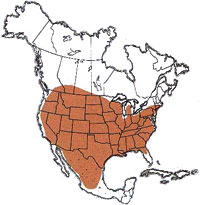Snakeweed
Grasshopper
|
|
|
|
Geographic range of Hesperotettix viridis (Thomas) |
|
|
Distribution
and Habitat
Economic
Importance
Food
Habits
Migration
and Dispersal
Identification
Hatching
Nymphal
Development
Adults
and Reproduction
Population
Ecology
Daily
Activity
Selected
References
Click here for the printable version
Distribution and Habitat
The snakeweed grasshopper has a wide geographic range in North America. Limited to areas where one or more of its host plants occur, its distribution is patchy, particularly in the East where it is less common than in the West. Host plants, usually certain low shrubs belonging to the composite family of plants, grow in numerous habitats including all grasslands, sagebrush and other shrub associations, and abandoned fields.
Economic Importance
The snakeweed grasshopper is a beneficial insect, as it feeds on rangeland plants with little or no forage value for livestock that intensively compete for soil moisture and hinder the growth of high quality forage plants. Some of the preferred host plants, such as the snakeweeds, are poisonous. Cattle, horses, sheep, and goats may ingest sufficient quantities of shoots and seedlings in the spring to cause illness and pregnant females to abort.
In New Mexico, feeding injury by this grasshopper has been shown to cause high mortality among seedlings and one-year-old plants of threadleaf snakeweed. As the plants age they become more tolerant to feeding damage, yet high densities of this grasshopper will consume all leaves and much of the stem cortex of older plants, contributing to their early death. A study is being undertaken in New Mexico to determine the feasibility of using this grasshopper as a biological control agent against broom snakeweed.
The snakeweed grasshopper is a medium-sized species. Average live weight of males from the mixedgrass prairie of eastern Wyoming is 212 mg and of females 344 mg (dry weight: males 66 mg and females 83 mg).
Food Habits
The snakeweed grasshopper feeds on a wide variety of host plants over its extensive geographic range. All are forbs and most are members of the composite family of plants. Common host plants include broom snakeweed, threadleaf snakeweed, Missouri goldenrod, western ragweed, Douglas rabbitbrush, gray rabbitbrush, and burroweed. Examination of crop contents and field observations have shown that this grasshopper ingests a minimum of 34 species of forbs over its range. It also feeds in trace amounts on grasses, flower petals, pollen, fungi, and arthropods. Food preference tests indicate that this grasshopper prefers the snakeweeds to rabbitbrush and burroweed.
Its method of feeding has been observed in New Mexico on one of its preferred host plants, threadleaf snakeweed. The grasshopper roosts in the low shrub most of the day and feed during daylight hours in short bouts of less than three minutes. It attacks the edges of leaves, stem cortex tissue, and flower buds.
Dispersal and Migration
Wings of the snakeweed grasshopper are long; those of the females do not quite reach the end of the abdomen, while those of the males do. This grasshopper is able to disperse over long distances. A study in Colorado showed that the upper resident altitude of this species was 7,600 feet while "accidentals" were found in the mountains up to 11,500 feet. The distance between the highest resident altitude and the highest collection site of an accidental was approximately 12 miles.
Evasive flights begin about 9 a.m. DST on clear days when air temperature 1 inch above ground have risen to 68ºF. Because the adults usually roost 5 to 6 inches above ground level, they are resting at a lower ambient temperature. The flights are silent, straight, low (6 to 9 inches), and for short distances (2 to 6 feet). They usually begin from a perch on vegetation and end on vegetation, but they can begin from vegetation or ground and end on the ground.
Identification
|
Figures 1-5. Appearance
of the nymphal instars, their sizes, structures, and color
patterns. Notice progressive development of wing pads. BL=body
length, FL=Hind Femur Length. AS=number of antennal segments
|
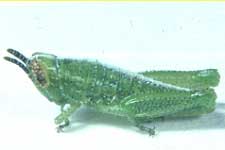 |
|
Fig. 1,
First Instar: BL 5.2-6.1 mm FL 2.4-3.1 mm AS 11-12.
|
 |
|
Fig. 2,
Second Instar: BL 6-8 mm FL 3.7-4.2 mm AS 14-17.
|
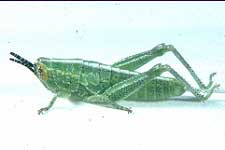 |
|
Fig. 3,
Third Instar: BL 8.3-9.1 mm FL 4.9-5 mm AS 17-18.
|
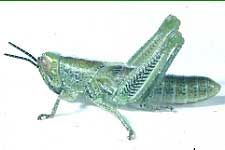 |
|
Fig. 4,
Fourth Instar: BL 11-14.2 mm FL 6.3-7.7 mm AS 19-20.
|
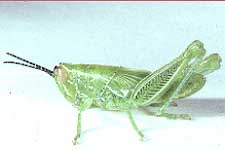 |
|
Fig. 5,
Fifth Instar: BL 14.8-16
mm FL 7.7-10.4 mm AS 20-22.
|
|
Figures 6-10. Appearance
of the adult male and female, head, cercus, and egg pod.
|
 |
|
Fig. 6,
Adult Male: BL 19-21 mm FL 9.8-11 mm AS 23-24.
|
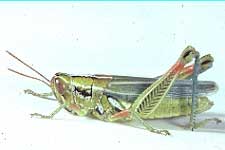 |
|
Fig. 7,
Adult Female: BL 20-22 mm
FL 11-12.5 mm AS 22-24.
|
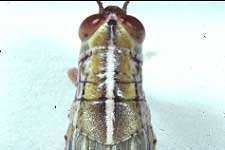 |
|
Fig. 8, Dorsal view
of head and pronotum of adult female.
|
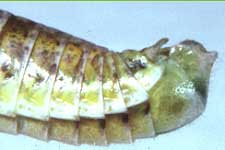 |
|
Fig. 9, End abdomen
showing preapical tubercle of male subgenital plate.
|
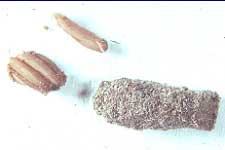 |
|
Fig. 10, Egg pod and
several loose eggs.
|
The adult snakeweed grasshopper is a green, medium-sized, spurthroated grasshopper possessing wings that reach or nearly reach the end of the abdomen (Fig. 6 and Fig. 7). A median light line begins on the occiput and continues posteriorly on the pronotal disk (Fig. 8). The fore and mid femora are pink and green; the hind femora are green with cream and fuscous chevrons and a distal pink annulus. The male subgenital plate has a large truncated, preapical tubercle (Fig. 9). The hind tibiae are light blue, often with distal end light green in females.
The nymphs are identifiable by their shape, structures, and color patterns (Fig. 1-5).
- Head: face moderately slanted; compound eyes with light spots on brown or burgundy background; fuscous antennae with segments having cream-colored rings anteriorly.
- Thorax: pronotum with cream-colored median carina; pronotal disk rounded, lacking lateral carinae; hind femur green in instars I to III, instars IV and V also green but with fuscous and cream chevrons, hind tibia green in instars I and II, light green or blue in instars III to V.
- General body color green with many fuscous spots. Median cream-colored line running from top of head to nearly end of abdomen, line at time absent from head.
Collections of grasshoppers from rangeland may include nymphs of Hesperotettix viridis and Hypochlora alba. Both species are spurthroated grasshoppers and green. The two can be separated by the following characteristics. 1. H. viridis is medium green, H. alba pale green. 2. Antennae of H. viridis are black with segments having a pale anterior annulus, H. alba have green antennae and may be spotted or suffused with brown in the older instars. 3. H. viridis has medial area of hind femur medium green and spotted black in instars I and II, and medium green with black chevrons in instars III to V, H. alba has the medial area of hind femur pale green and spotted brown or medium green.
Hatching
Eggs of the snakeweed grasshopper hatch two to three weeks after those of the bigheaded grasshopper, placing it in the intermediate hatching group. In the northern mixedgrass prairie of eastern Wyoming, hatching occurs in the middle of June. In New Mexico, this event occurs six weeks earlier.
Nymphal Development
In both Wyoming and New Mexico the nymphs complete development in about 55 days. This is 12 to 15 days longer than the period needed by rangeland grasshoppers that dwell on the ground. Evidently the time spent perched in the host plant keeps the snakeweed grasshopper at a lower average temperature, resulting in slower growth. In the laboratory the nymphal period of grasshoppers fed broom snakeweed averaged 74 days and of those fed threadleaf snakeweed 68 days. They pass through five instars before molting to the adult stage.
Adults and Reproduction
The majority of adults remain in the same habitat in which the nymphs developed. There they continue to feed and live on the same species of host plant. In the West this is usually snakeweed or rabbitbrush. Little is known about the snakeweed grasshopper's reproductive biology, including time taken from fledging to mating, courtship, and time of first oviposition. Adults have a relatively long period in which to reproduce. In northern New Mexico mating and oviposition begin in late June and continue through early September. A gravid female ready to lay a clutch of eggs elects a site at the base of its host plant in bare ground or in a clump of shortgrass. The eggs are laid in the soil at a depth of 1 inch and are enclosed in a tough-walled pod that measure about one-half inch long. In the region of the eggs the pod is two-to-three-sixteenths inch in diameter. It contains ten, tan eggs 4.3 to 4.7 mm long (Fig. 10). Immediately above the eggs the pods cap consists of a thin layer of froth. Embryos of eggs laid and retained in the laboratory at warm temperature develop to stage 19, then dispause. This is the embryonic stage in which many grasshopper species diapause and overwinter. Evidently, the snakeweed grasshopper likewise overwinters in this embryonic stage at a depth of 1 inch in the soil. The species has one generation annually. Fed an exclusive diet of broom snakeweed in the laboratory, this grasshopper produced approximately six eggs per female while those feed threadleaf snakeweed produce 28 eggs per female.
Population Ecology
Because the snakeweed grasshopper is an oligophagous species that restricts its feeding to several members of the Compositae, the existence of populations of this grasshopper depends on the presence of at least on of its host plants. In the West the host plants is often a single species of snakeweed or rabbitbrush.
Growth and size of populations are limited by the quality and the density of the host plants. Snakeweed grasshoppers feed and remain longer on threadleaf snakeweed plants that have not been damaged by herbivory or by lack of water. Nymphs grow more rapidly on undamaged, healthy plants.
The importance of density or amount of biomass of host plant in the habitat is indicated by a comparison of populations in eastern New Mexico and in eastern Wyoming. In New Mexico 50-acre islands of broom snakeweed infestation by two adult grasshoppers per plant represent a population density of approximately 15 grasshoppers per square yard, whereas in mixedgrass prairie of Wyoming two adult grasshoppers per plant represent only 1.2 to 1 grasshopper per square yard. This difference is obviously due to the lower host plant densities in the Wyoming habitat.
Densities of snakeweed grasshopper populations are known to vary annually. A population infesting threadleaf snakeweed in New Mexico reached a peak in 1980. The grasshoppers severely damaged their host plant, which not only suffered from the herbivory, but also from inadequate moisture during a drought. The following year, the population decreased to less than half its former density.
No comprehensive study of the population ecology of the snakeweed grasshopper has been made. Plans for an early use of this grasshopper as a biological control agent of broom snakeweed are hampered by the paucity of ecological information.
Daily activity
The snakeweed grasshopper is a phytophilous species, as it spends most of its active live on the host plant. Both the nymphs and adults roost head up on stems of snakeweed during the nights. Shortly after sunrise they may begin basking by turning a side perpendicular to rays of the sun, still roosting vertically on the host plant. Later, by 8 a.m. DST, adults take basking positions on the soil surface. Resting horizontally, they expose a side perpendicular to ray of the sun and lower the exposed hindleg to the ground. Mating pairs take similar basking positions on the ground surface. Basking may continue on the ground until 10 a.m. after which other activities begin such as pottering and jumping back onto the host plant where feeding and mating occur. In the evening, individuals that are still on the ground eventually crawl to within 6 inches of their host plant and then jump into it and take roosting positions on stems. In late evening (8 p.m.) the grasshoppers may continue to feed on the foliage or they may bask as the sun wanes.
Selected References
Alexander, G. And J. R. Hilliard, Jr. 1969. Altitudianal and seasonal distribution of Orthoptera in the Rocky Mountains of northern Colorado. Ecol. Mongr.39:385-431.
Fry, B., A. Joern and P.L. Parker. 1978. Grasshopper food web analysis: use of carbon isotope ratios to examine feeding relationships among terrestrial herbivores. Ecology 59:498-506.
Mulkern, G. B., K. P. Pruess, H. Knutson, A. F. Hagen, J. B. Campbell, and J. D. Lambely. 1969. Food habits and preferences of grassland grasshoppers of the North Central Great Plains. North Dakota Agr. Exp. Stn. Bull. 481.
Parker, M. A. 1984. Local food depletion and the foraging behavior of a specialist grasshopper, Hesperotettix viridis. Ecology 65:824-835.
Thompson, D. C. And D. B. Richman. 1989. The role of native insects as snakeweed biological control agents. In Snakeweed: Problems and Perspectives. New Mexico Agr. Exp. Stn. Bull. 751.
Thompson, D. C. and D. B. Richman. 1993. A grasshopper that only eats snakeweed? In Snakeweed Research Updates and Highlights. New Mexico Agr. Exp. Stn. Research Report 674:18-19.
Thompson, D.C. and T.M. Sterling. 1993. Snakeweed species influenced snakeweed grasshoppers differently. In Snakeweed Research Updates and Highlights. New Mexico Agr. Exp. Stn. Research Report 674:20-21.
